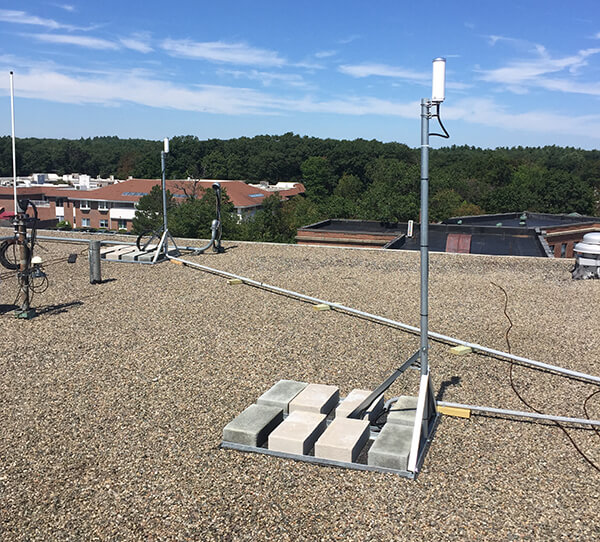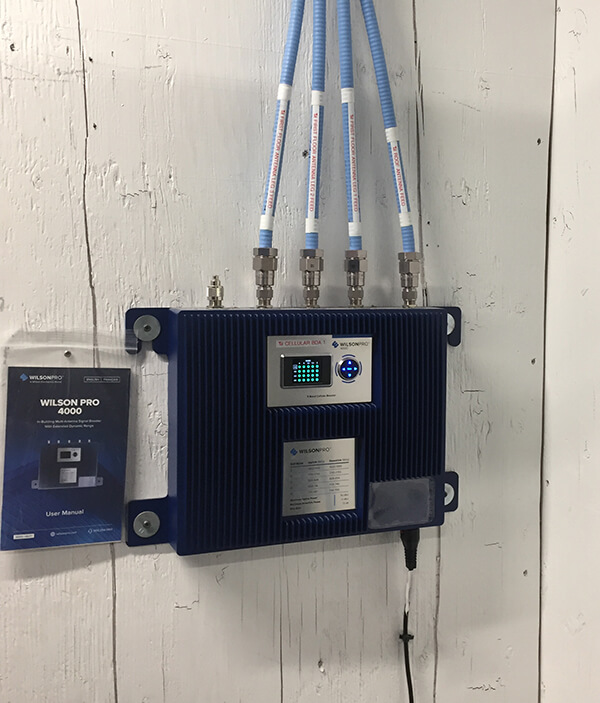Many businesses struggle with poor cell coverage in their workplace. “Green” buildings with LEED certified windows and older buildings with thick brick walls can both struggle with this issue. There is a simple solution to the problem: cellular Bi-directional Antennas (BDAs). Many business owners – and even their IT professionals – are unsure what a cellular BDA is and how it works and so they continue to endure poor cell coverage. So, let’s take a few minutes to clarify what a cellular BDA does and address some common misconceptions about them.

A cellular BDA is comprised of three parts. An antenna mounted outside the building, a signal amplifier which is typically housed in an IT or wiring closet inside the building, and internal antennas (dome or panel) which are strategically and discreetly placed throughout the inside of the building to boost the signal.
The outdoor antenna size is typically between nine and 12 inches long and is mounted to a mast which is fixed on the roof (photo 1). The mast height can vary to accommodate architectural aesthetics but is generally about six feet tall. It is placed out of the line of sight so, unless you know to look for it, no one can see it from the ground. One of our clients has a historic property and they had the antenna installed behind a clock tower. Visitors have no idea it is there. The antenna is pointed at the nearest cell tower and receives the signal. It then directs the signal inside the building. It does not emit any signal of its own. It merely redirects the cellular signal.

The outdoor antenna size is typically between nine and 12 inches long and is mounted to a mast which is fixed on the roof (photo 1). The mast height can vary to accommodate architectural aesthetics but is generally about six feet tall. It is placed out of the line of sight so, unless you know to look for it, no one can see it from the ground. One of our clients has a historic property and they had the antenna installed behind a clock tower. Visitors have no idea it is there. The antenna is pointed at the nearest cell tower and receives the signal. It then directs the signal inside the building. It does not emit any signal of its own. It merely redirects the cellular signal.
The outdoor antenna transmits the signal to the amplifier. This is typically a box about 18 inches by 12 inches tucked into a closet and never seen. It can even be rack mounted. The amplifier is connected to the dome antennas that are strategically placed throughout the workspace.
The dome antennas are placed on the ceiling and are about the size and shape of a smoke detector. Their range is about 50 feet so they are positioned about 100 feet apart. They are unobtrusive; but they offer an enormous improvement in the cellular signal inside the building.
Let’s dispel some common misconceptions about cellular BDAs:
- A cellular BDA antenna is not large nor is it an eyesore and, in fact, we work diligently to place them discreetly out of sight.
- A cellular BDA does not affect coverage of neighboring buildings or businesses. It merely boosts the signal to your building making your coverage better.
- A cellular BDA does not interfere with other communications, e.g. radar etc. because it does not produce a signal of its own. It redirects the existing cellular signal that is already emitted by the nearby cell tower.
Cellular BDAs are a simple fix to an annoying and common problem. They can be installed unobtrusively in your workspace and dramatically improve your communication.
If you have more questions about how a cellular BDA works and how we can help you design a cellular BDA that fits your workplace contact us.
